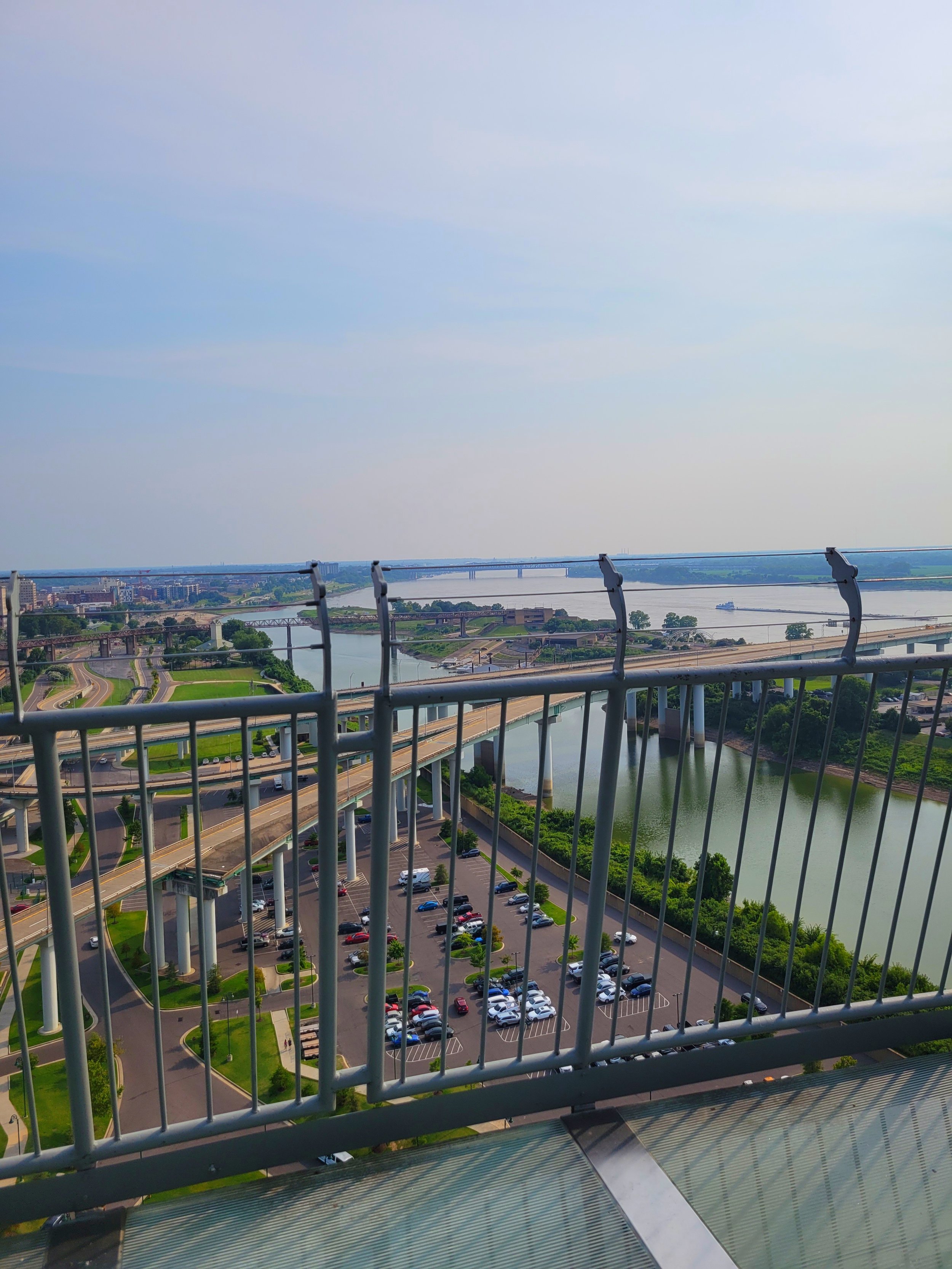Memphis in Living Color
This Thanksgiving, I spent time with my dad’s side of the family in Memphis, Tennessee. While I have been to Memphis before, I had never been without my younger sisters, so I took time out of my vacation to explore Memphis without having to consider the interests of middle school students. As I drove around Memphis, I visited many historical sites which are relevant to important moments in Black history. I looked up some of these sites and moments in The HistoryMakers Digital Archive to take a deeper look inside.
A shot of the Mississipi River I took from the observation deck of the Bass Pro Shops Pyramid.
One of the first sites I visited was Beale Street Baptist Church, which was built in 1869 by a congregation of freed slaves. Sometimes referred to as the mother of Black churches, Beale Street Baptist has long been a cornerstone of Memphis’ social and political activism. Over the years, Beale Street Baptist has hosted a number of notable speakers, including President Ulysses S. Grant and A. Philip Randolph. HistoryMaker Ernest Withers spoke about the history of Beale Street Baptist Church during his interview. According to Withers, A. Philip Randolph spoke at Beale Street Baptist in defiance of city leaders after Memphis Police shot and killed a mentally ill man. This led to the church being shut down by the city. “E. H. [Edward Hull] Crump and the powers that be decided that because Reverend [George A.] Long let this preacher--let A. [Asa] Philip Randolph… speak, and draw this horrendous crowds of protesters… they condemned the Beale Street Baptist Church, and it was to be torn down. But political whites and blacks came together and got that pulled away, and the church is still in existence.” The Beale Street Baptist Church still stands today as a reminder of the history of Memphis.
The entrance to Beale Street Baptist Church.
Another site I visited was Mason Temple. Mason Temple is the Global Headquarters of the Church of God in Christ, which is the second-largest Black denomination of Christianity in the United States. Mason Temple is notable not only because of its impact on the Black Christian community, but because of the role it played in the Civil Rights movement. Rev. Dr. Martin Luther King, Jr., gave his famous “Mountaintop“ speech at Mason Temple on April 3rd, 1968, the night before he was assassinated. HistoryMaker William Lucy recalled Martin Luther King’s involvement in Memphis activism prior to his assassination. “Well, I, I think as, as, as Dr. King analyzed what was going on… he felt very strongly and identified with them, with their desire to have a union. He spoke at Mason Temple [Mason Temple Church of God in Christ, Memphis, Tennessee] and really got caught up in the, in, in the crowd commitment to this… So when he saw Memphis and that fact that the city by then, at least the black community by then, had come to support it, he was impressed with the solidarity that was being shown.” Had Martin Luther King not been assassinated at the Lorraine Motel in Memphis the next day, he might have come back to Memphis to support the laborers and poor Black people who were fighting for recognition from the city. His speech at Mason Temple is a major part of Black history and of history in Memphis.
The inside of Mason Temple.
One of the most impactful sites I visited in Memphis was the I AM A MAN Plaza. The Plaza commemorates the Memphis Sanitation Workers Strike in 1968. In February of 1968, two sanitation workers were crushed to death by a garbage compactor as they attempted to seek shelter from the rain. Their deaths were mourned by the entire community of sanitation workers, who then began to discuss the unfair treatment and low wages they all received. These discussion led to a strike of over 1,000 sanitation workers. City leadership was largely unresponsive to the strike and tried to end the strike in a plethora of different ways, but the sanitation workers persisted. HistoryMaker Maxine Smith spoke about her involvement in the Sanitation Workers Strike. “Uh-huh, as I say we had been picketing whoever, the commissioner that was head of public services, we'd make signs, we'd go to their meetings and, they were so pitiful. They had to carry those garbage cans home and the seepage would be--we used to go up and they had a little place where they would meet. And it would be stinking you know from the drippings from the garbage. And we worked with them for years... we are all products of our society, and, at some point we have to break it, break through, I ain't gonna take this no more, I ain't gonna take this no more.” After the assassination of Martin Luther King, Jr., and continued protests, the city government acknowledge the strike and made working conditions safer for sanitation workers. However, those conditions were not perfect, and there are still improvements to be made today.
A shot I took of the centerpiece at the I AM A MAN Plaza.
I learned a lot about Black history and the Civil Rights Movement from my time in Memphis. I am glad I was able to take a deeper dive into the locations I visited with The HistoryMakers Digital Archive. As I spend more time in different cities, I hope to gain a more layered and thorough image of Black history in those cities through the Digital Archive.




